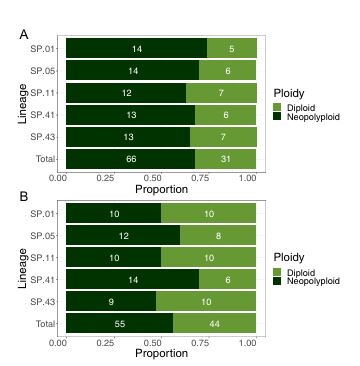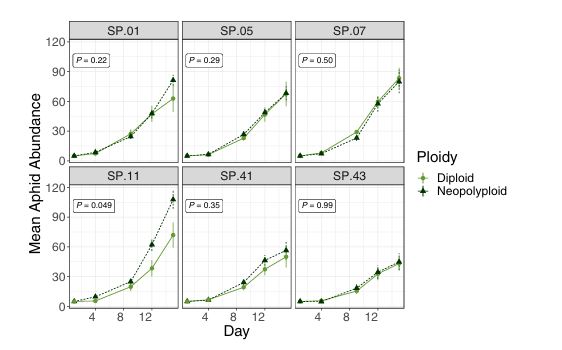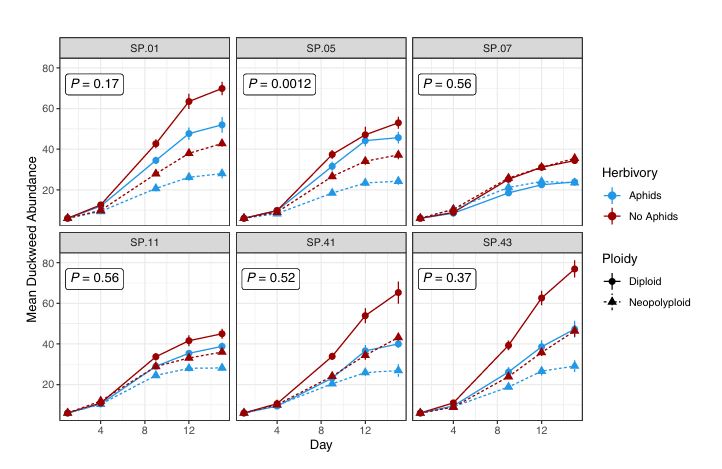Neopolyploidy-induced changes in giant duckweed (Spirodela polyrhiza) alter herbivore preference and performance and plant population performance
1/10
There's no tags or description
Looks like no tags are added yet.
Name | Mastery | Learn | Test | Matching | Spaced |
|---|
No study sessions yet.
11 Terms
What is the main question of this paper
The main question in this paper investigates how neopolyploidy, or recent whole-genome duplication, in giant duckweed (Spirodela polyrhiza) impacts interactions with the water-lily aphid (Rhopalosiphum nymphaeae).
Specifically, it explores whether neopolyploid plants influence herbivore preference and performance, and if these effects vary based on the genetic background of the duckweed.
Main methods used: Paired-Choice Experiments
These experiments tested whether aphids preferred feeding on diploid or neopolyploid duckweed, using either equal numbers of plants or equal total surface area to account for the size differences between ploidies.
Main methods used: Performance Trials
The authors conducted a full factorial growth chamber experiment to measure both aphid population growth and duckweed biomass over 15 days. This involved tracking plant and aphid performance across multiple genetic lineages of duckweed.
Key Results: Aphid Preference
Aphids preferred neopolyploid duckweed when plant abundance was controlled, but this preference disappeared when plant surface area was controlled, suggesting size may drive this preference.
Key Results: Aphid Performance
Neopolyploids generally supported higher aphid populations, but the extent of this effect depended on the genetic lineage of the duckweed.
Key Results: Duckweed Tolerance to Herbivory
Some neopolyploid lineages showed lower tolerance to aphid herbivory, as evidenced by reduced biomass and abundance, though this effect varied significantly among genetic lineages.
Key Results: Findings
These results imply that polyploidy, along with genetic background, can significantly shape plant-herbivore dynamics.

Figure 1
Questions, Methods, Results
Question: Do aphids show a preference for feeding on diploid or neopolyploid duckweed?
Methods: In paired-choice experiments, aphids were presented with duckweed fronds from both ploidies. Two setups were used: one controlling for frond number (abundance-controlled) and another controlling for total surface area (area-controlled).
Results: Aphids preferred neopolyploids over diploids when frond abundance was controlled. However, this preference disappeared when the plant surface area was controlled, indicating that aphid preference is likely influenced by plant size differences.

Figure 2
Questions, Methods, Results
Question: Does duckweed ploidy affect aphid population performance?
Methods: Aphids were allowed to feed on both diploid and neopolyploid duckweed from different genetic lineages in a growth chamber. Aphid population sizes were measured over time.
Results: Aphids generally had higher population growth on neopolyploid duckweed, but the extent varied significantly between genetic lineages. For instance, aphids on the SP.11 neopolyploid lineage showed greater growth than on the diploid SP.11, whereas SP.07 neopolyploids supported fewer aphids compared to SP.07 diploids.

Figure 3
Questions, Methods, Results
Question: How does aphid herbivory affect the performance of neopolyploid and diploid duckweed populations?
Methods: Duckweed populations (both diploid and neopolyploid) from different genetic lineages were subjected to aphid herbivory in a controlled environment, and population abundance was measured.
Results: The impact of aphid herbivory on duckweed abundance varied with ploidy and genetic lineage. Neopolyploid lineages like SP.05 were more negatively impacted by herbivory, indicating lower tolerance in terms of population abundance under aphid pressure.

Figure 4
Questions, Methods, Results
Question: Is the final biomass of duckweed different between ploidies in response to herbivory?
Methods: After a 15-day experiment, the dry biomass of duckweed was measured to assess the effect of aphid presence on final plant performance.
Results: Neopolyploid duckweed biomass was slightly more affected by aphid herbivory than diploids, with the degree of impact varying by lineage. Lineages such as SP.05 and SP.11 showed lower tolerance, as evidenced by reduced biomass under aphid pressure